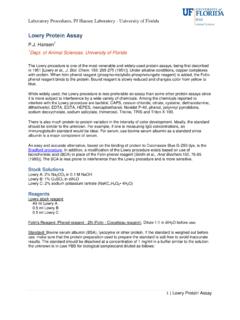Transcription of Protocol for collection of embryos to be used for ...
1 Protocol for collection of embryos to be used for molecular biology experiments Anna Denicol This Protocol is intended to maximize sample quality for DNA and RNA analysis. When collecting samples for molecular biology purposes, work in the IVF lab as if you were in the molecular biology bench. Wear gloves and be very careful about pipette tips (change them frequently and especially if you suspect a tip touched anything other than the relevant solution). 1. Materials: - Gloves;. - RNAse wipes;. - For washing and pronase-treating embryos when removing them from the culture drops, use aliquots from the plastic boxes inside the IVF fridge molecular biology use only (see picture below) these aliquots are for single use. - Use new plates for washing and pronase-treating embryos (same as used for IVF) the left over lids and plates are good for fixing embryos in paraformaldehyde, but they are not adequate for avoiding RNase contamination.
2 - DEPC-treated DPBS/PVP - one aliquot;. - Take 1 aliquot of pronase and 1 aliquot of autoclaved 2x DPBS for pronase dilution from the fridge;. - Before starting embryo collection , make 50 l-pronase drops by mixing 25 l of pronase and 25 l of 2xDPBS, close the lid of the plate and let the drops warm for 20 minutes (to decrease the time embryos are exposed to pronase);. - Eppendorf tubes from the molecular biology area and label to identify your samples;. - Small styrofoam box with liquid nitrogen (just enough to snap freeze samples). 2. Procedure: - Wear gloves;. - Before starting harvesting embryos , clean microscope, area around it, warmer plate and pipettes with alcohol followed by a RNAse wipe;. - Take embryos from culture drop and wash twice in a 50 l drop of autoclaved, DEPC-treated DPBS/PVP ;. - Place embryos in pre-warmed drops of pronase;. - Place plate back in the warmer plate;. - Check embryos for ZP dissolution after 1 min.
3 - Remove embryos from pronase AS SOON as the ZP is dissolved;. - Wash embryos 3x in 50 l drop of autoclaved, DEPC-treated DPBS/PVP ;. - From the last drop, pick embryos together with 5 ul of DPBS/PVP and place in the previously labeled Eppendorf tubes;. - Snap freeze samples in liquid nitrogen;. - Immediately place samples in your box in the -80 C freezer. Boxes containing single use aliquots of 1) pronase, 2) 2x DPBS and 3) DPBS/PVP These are located inside the IVF refrigerator. Use the pronase within 1 mo of preparation. 3. How to prepare the solutions needed: DEPC-treated water: - Wear gloves;. - Turn on oven in the main lab and make sure it is reading 37 C;. - Fill one autoclaved bottle with 1 liter of double-distilled water (from the big water containers in the main lab);. - Add 1 ml of DEPC (Sigma; 40718). DEPC is in a 5 ml-container kept in the molecular biology drawer of the walk-in 4 C;. - Mix very well for all DEPC to dissolve in the water.
4 - When all DEPC is dissolved, place bottle in the oven at 37 C; keep it in oven for at least 24 h;. - Autoclave DEPC-treated water twice;. - Clean the hood in the IVF room with RNAse wipe and make 5-ml aliquots of DEPC water using a new bag of 15 ml falcon tubes (orange cap);. - Place aliquots and leftover DEPC-treated water in the molecular biology cabinet (room temperature). DPBS/PVP in DEPC-treated water: - Wear gloves;. - Prepare DEPC-treated water as described above;. - Add one bottle of powder DPBS to DEPC-treated water (one bottle of DPBS is enough to make 1 L);. - Measure (w/v) PVP (1 g/L) and add to the bottle containing DPBS;. - Mix well until powders are completely dissolved;. - Autoclave;. - Clean the hood in IVF room using RNAse wipe and prepare 2 ml-aliquots using Eppendorf tubes;. - Place aliquots in plastic box inside refrigerator in the IVF room (see picture above);. - Place left over DECP-treated DPBS/PVP in the molecular biology reagents shelf inside the walk-in 4 C.
5 DEPC-treated 2x DPBS (for making pronase working solution): - Wear gloves;. - Use the exact same procedure as described above for DEPC treatment of water;. - Take 500 ml of DEPC-treated water and add one bottle of powder DPBS (this will give a two times concentrated DPBS);. - Autoclave;. - Clean the hood in IVF room using RNAse wipe and prepare 500 l-aliquots using ml microcentrifuge tubes;. - Place aliquots in plastic box inside refrigerator in the IVF room (see picture above);. - Place left over DECP-treated DPBS 2x in the molecular biology reagents shelf inside the walk- in 4 C. Pronase This solution is made as a stock at concentration. Immediately before use, make pronase by diluting equal volumes of pronase and DEPC-treated DPBS 2x (this can be done directly in the plate);. - Wear gloves;. - Clean the hood in IVF room using RNAse wipe;. - Measure 10 ml of sigma water in a sterile 15 ml falcon tube (orange cap).
6 - Measure (w/v) of pronase ( g in 10 ml of sigma water);. - Add pronase powder to tube containing sigma water and mix well for complete dissolution;. - In the hood, make 500 l-aliquots using ml microcentrifuge tubes;. - Place aliquots in plastic box inside refrigerator in the IVF room (see picture above). Using Qiagen RNeasy Micro Kit to extract and isolate RNA from embryo samples The Qiagen Protocol follows similar steps to the Picopure Protocol . However, there are a few differences in the sequence of steps, so follow the Protocol contained in the kit box. All steps in the Protocol have been designed to optimize sample yield and quality. Therefore, FOLLOW all steps exactly as they are described in the Protocol . Start RNA extraction by thawing your embryo pellet (see section 2 procedure) and adding the RLT+ -ME to it. Follow all steps until completion. One modification from the Picopure kit: - Qiagen kit has a DNase step during RNA isolation.
7 DNase I to be used here is in the -20 C, in a plastic box identified as DNase I aliquots for RNeasy micro kit. Thaw one aliquot for each sample you are isolating. One kit is enough to isolate RNA from 50 samples. Two modifications that both Qiagen technical support and ICBR gene sequencing lab manager suggest for increasing RNA concentration: - When eluting RNA (final step), you can use 10 l instead of the 14 l specified in the kit manual. - After the first elution, take the flow through, place in the column and elute again (same speed and time in the centrifuge). This will give you a final eluted volume of approximately 8 l. Note: decreasing the elution volume is more important when working with 20 embryos or fewer. If using more than 20 embryos , elute in 14 l. You can still elute the sample twice as described above.






